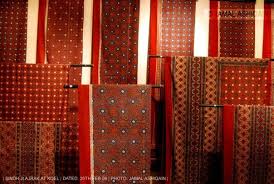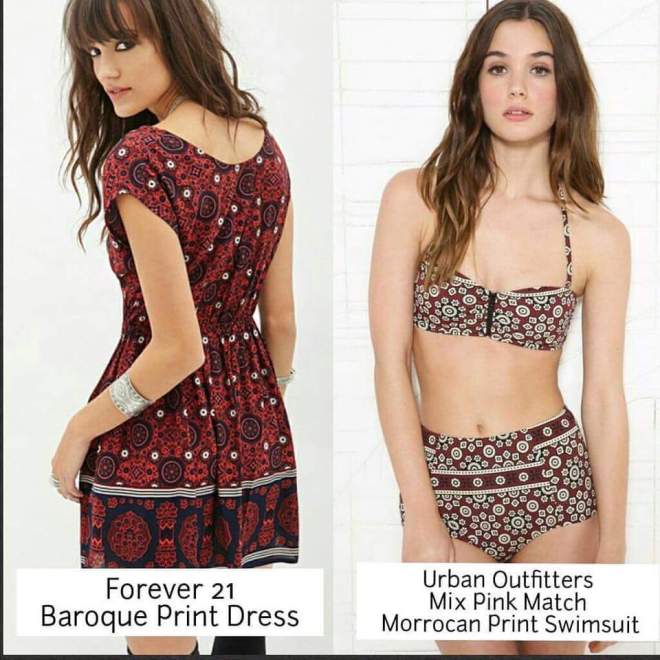I really hate that I have to call out yet another Western designer/company after the Paul Smith debacle of a couple of years ago when they took the Peshawari chappal and claimed it as their own design. But here we go again, and this time the culprits are Forever 21 and Urban Outfitters, who have taken Sindh’s ajrak and called it “Baroque Print” or “Moroccan print” (also “Elephant Print“).
Not only have they done this but they’ve also made a dress and a bikini out of it respectively – the dress isn’t so bad but the bikini is an insult to Sindhis, as we don’t believe in taking this piece of cloth and putting it on your ass. A couple of years ago I saw a non-Sindhi Pakistani man who made a pair of pants out of ajrak and was prancing around in them like some kind of crazed gazelle. Even after he was told by several of us Sindhis that it was very inappropriate, he said, “I don’t care,” and continue to prance, breaking all our hearts simultaneously.
The ajrak is a cotton blockprinted cloth produced in Sindh, the southernmost province of Pakistan. It is dye d with indigo and vegetable dyes from plants grown on the banks of the Indus River. Every Sindhi has at least one in their household. They’re worn as turbans, shawls, quilts, used to wrap belongings or carry children, used to decorate homes. When an honored guest visits a Sindhi, we will gift them an ajrak by draping it over their shoulders.
d with indigo and vegetable dyes from plants grown on the banks of the Indus River. Every Sindhi has at least one in their household. They’re worn as turbans, shawls, quilts, used to wrap belongings or carry children, used to decorate homes. When an honored guest visits a Sindhi, we will gift them an ajrak by draping it over their shoulders.
Ajraks are our pride and our heritage. They mark us symbolically as people from the land of Sindh, a beautiful province of peace and tolerance. An ajrak is a cloth of honor for honorable people. You don’t take someone’s honor and do THIS to it. Yeah, you’re going to say it was “inspired” and you put your own twist on it, but try fooling someone else, please.
How many times will Western companies take something from us and turn it into a crass moneymaking travesty? I’m getting really tired of pointing out the cultural appropriation. When will you learn your lesson?
EDIT: Pakistani writer Moni Mohsin tells me Isabel Marant also “plundered” Sindhi textiles for her SS2016 collection. This isn’t ajrak, but it does definitely have similarities to cloth patterns woven in Sindh and Balochistan.
Thanks to Syed Ahmed Bukhari whose article “Whose Clothes Are These Anyway” had the original images reproduced below.

Oh wow you took this image and failed to mention where did you find it and who posted it.
LikeLike
Tell me where it’s from and I’ll update. I didn’t know when I saw it floating around on Twitter.
LikeLike
This is the link to the original post
LikeLike
This is specific pattern that belong to 8000 years old civilizations called “Sindh/Indus Civilization”, and this pattern has a name “AJRAK”. You can google Ajrak to learn more.
LikeLike
This is ajrak 101%….
LikeLike
LikeLike
As a Sindhi, I couldn’t agree more. Cultural appropriation is just wrong, our heritage and culture is not theirs to claim.
LikeLike
If the above is correct it is easily rectified here in the UK. Either through Twitter or FB message urban outfitters so they are made aware of the offense that it can cause in the first instance and if that doesn’t work then you threaten boycott and protests at there stores!!! Commercial enterprises only understand the meaning ‘offensive’ when there is the slight chance it will effect £$€ profits..
LikeLike
You can use it but don’t steal it ! It is our heritage , belongs to Sind Pakistan , label it as it belongs to Sind ,
LikeLike
Hi ,can you please tell me where you saw my post? Thanks!
LikeLike
I bought a pair of pants/trousers from a Karachi boutique made from ajrak. Had no idea it was insulting. Wonder why it’s being used in Karachi then, where awareness of Sindhi culture is obviously much higher than elsewhere
LikeLike
I died laughing at the crazed gazelle part.
LikeLiked by 1 person
its Sindhi Ajrak, part of Cultural dress of ppls of Sindh, almost more then 5000 years old design. No other one can claim regarding design.
LikeLike
I turned my ajrak into a curtain in my kitchen. One of my Sindhi friends thought I was nuts to do even that. I found it to be the most respectful and beautiful way to view such a wonderful piece of fabric art.
example: Tartans are a big part of scottish cultural heritage, but I am not going to start writing about the misappropriation of hipsters wearing random flannels with no knowledge of what each particular woven color pattern means or represents.
Sometimes a breath of fresh air is needed when viewing things as such. While I do get the point that some particular pieces may be somewhat disrespectful, others are generally free to wear or do with things as they wish. The labeling the items other than their origin is quite a classic piece of jackassery though.
LikeLike
Thank for research about the sindhi culture and give value the ajrak , nice article for promoting sindhi and peshwari cloth and shoes good awareness Peshawari chappal
LikeLike